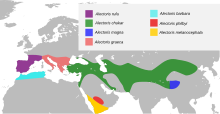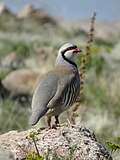| Alectoris | |
|---|---|

| |
| Chukar partridge (Alectoris chukar) | |
| Scientific classification | |
| Domain: | Eukaryota |
| Kingdom: | Animalia |
| Phylum: | Chordata |
| Class: | Aves |
| Order: | Galliformes |
| Family: | Phasianidae |
| Tribe: | Coturnicini |
| Genus: | Alectoris Kaup, 1829 |
| Type species | |
| Perdix petrosa | |
| Species | |
|
See text. | |

| |
| Rough distributions of species in the genus Alectoris | |
Alectoris is a genus of partridges in the family Phasianidae, closely related to Old World quail (Coturnix and relatives), snowcocks (Tetraogallus), partridge-francolins (Pternistis), bush quail (Perdicula), and sand and see-see partridges (Ammoperdix). Members of the genus are known collectively as rock partridges (a name that also refers to one species in particular, Alectoris graeca). The genus name is derived from the Ancient Greek: αλέκτωρ, romanized: alektoris, meaning "chicken" or "farmyard fowl".
Their fossils date back to the early Pleistocene, with extant representatives in southern Europe, North Africa and Arabia, and across Asia in Pakistan to Tibet and western China.
Description
These are non-migratory birds of dry, open and often hilly country. They nest in a scantily lined ground scrape laying up to 20 eggs. They feed on a wide variety of seeds and vegetation. Ants are a very important source of nutrition for the birds as are pine nuts, juniper berries and lichens.
As is typical of many galliform birds, Alectoris partridges are relatively round-bodied and small-headed. They typically have a light brown or grey back, grey breast, buff belly, and barred flanks. Several species have a whitish throat with a black border. Their specialized flank coverts give them the appearance of being more rotund than they actually are. Their legs are red, with well-developed, ball-peen hammer-like spurs. When disturbed they run very rapidly, often uphill, taking to the wing if pressed. Their wings are long and fairly sharp, shaped rather like those of ptarmigan and spruce grouse, suggesting that the birds sustain themselves in flight over substantial distances to find food. This probably occurs most often during winter.
Introduced species and hybridisation
Some members of the genus, notably the chukar and red-legged partridge, have been introduced to many locations outside their natural range; there are now established populations of chukar in western North America, Hawaii, and the South Island of New Zealand, and of red-legged partridge in the United Kingdom, the Azores, Madeira, and the Canary Islands.
The chukar readily interbreeds with the red-legged partridge and rock partridge. The practice of breeding and releasing captive-bred chukar and hybrids between chukar and red-legged partridge has been banned in the United Kingdom, as it is a threat to red-legged partridge populations.
Species
The genus contains seven species:
| Image | Common Name | Scientific Name | Distribution |
|---|---|---|---|
 |
Barbary partridge | Alectoris barbara | North Africa, and is also native to Gibraltar and the Canary Islands |
 |
Arabian partridge | Alectoris melanocephala | southern Saudi Arabia, Yemen and western Oman. |
 |
Red-legged partridge | Alectoris rufa | Iberian Peninsula, France, Italy and Balearic Islands |
 |
Chukar partridge | Alectoris chukar | Jordan, Israel, Palestine, Lebanon, Syria, Turkey, Iraq, Iran, Uzbekistan, Afghanistan, Tajikistan, Pakistan and India |
 |
Rock partridge | Alectoris graeca | Serbia, Albania, Italy, and France to Greece and Bulgaria |
 |
Philby's partridge | Alectoris philbyi | Saudi Arabia and Yemen |
| Przevalski's partridge | Alectoris magna | China(Gansu, Qinghai) |
A prehistoric species, A. peii, is known from China. Another one, A. baryosefi, has been described from Early Pleistocene fossils found at El-`Ubeidiya (Jordan valley), Israel.
See also
References
- "Phasianidae". aviansystematics.org. The Trust for Avian Systematics. Retrieved 2023-08-05.
- Jobling, James A. (2010). The Helm Dictionary of Scientific Bird Names. London: Christopher Helm. p. 41. ISBN 978-1-4081-2501-4.
- Barilani, Marina; Bernard-Laurent, Ariane; Mucci, Nadia; Tabarroni, Cristiano; Kark, Salit; Garrido, José Antonio Perez; Randi, Ettore (June 2007). "Hybridisation with introduced Chukars (Alectoris chukar) threatens the gene pool integrity of native Rock (A. graeca) and Red-legged (A. rufa) Partridge populations". Biological Conservation. 137 (1): 57–69. Bibcode:2007BCons.137...57B. doi:10.1016/j.biocon.2007.01.014. Retrieved 15 April 2020.
- "Red-legged partridge". Game & Wildlife Conservation Trust. Retrieved 2015-12-25.
- Gill, Frank; Donsker, David; Rasmussen, Pamela, eds. (July 2021). "Pheasants, partridges, francolins". IOC World Bird List Version 11.2. International Ornithologists' Union. Retrieved 25 November 2021.
| Genera of landfowl and their extinct allies | |||||||||||||||||||||||||||||||||||
|---|---|---|---|---|---|---|---|---|---|---|---|---|---|---|---|---|---|---|---|---|---|---|---|---|---|---|---|---|---|---|---|---|---|---|---|
| |||||||||||||||||||||||||||||||||||
| |||||||||||||||||||||||||||||||||||
| |||||||||||||||||||||||||||||||||||
| |||||||||||||||||||||||||||||||||||
| |||||||||||||||||||||||||||||||||||
This Galliformes article is a stub. You can help Misplaced Pages by expanding it. |



